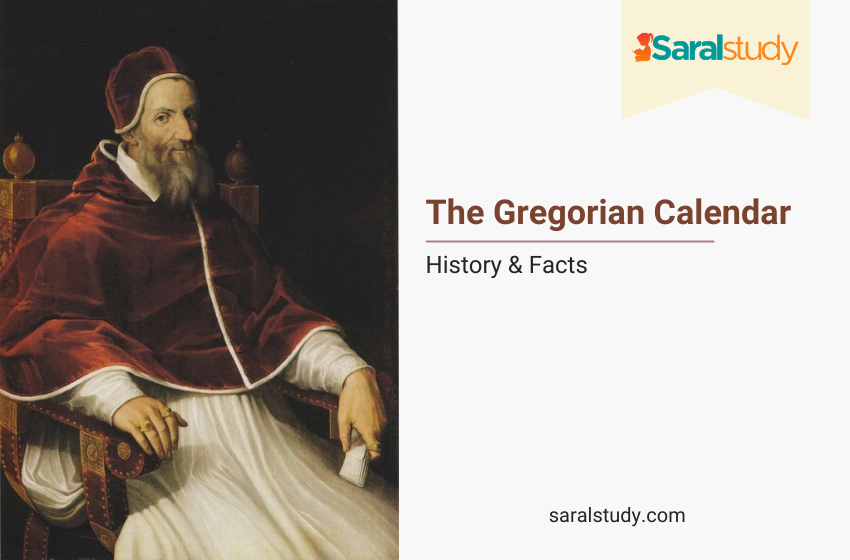The Gregorian Calendar – History and Facts

Gregorian Calendar, also known as New Style Calendar, solar dating system is generally in use. It was constructed by Pope Gregory XIII in 1582 in the place of the Julian Calendar. Today, The Gregorian Calendar is accepted internationally and has become a civil calendar which also makes it a Western or Christian calendar.
Table of Contents
Calendar Irregular with 12 Months
In the modern-day Gregorian Calendar, there are 12 months in one year and these months are either 28, 29, 30, or 31 days long. A common year in this solar calendar consists of 365 days is having either 28, 30, or 31 days in one month whereas during leap year which occurs every 4 years this calendar adds one extra (intercalary) day and makes that year 366 days long, this one day has been added to the month of February making it 29 days long which generally is 28 days long.
There are 12 months in the Gregorian calendar:
- January – 31 days
- February – 28 days (common year) and 29 days (leap year)
- March – 31 days
- April – 30 days
- May – 31 days
- June – 30 days
- July – 31 days
- August – 31 days
- September – 30 days
- October – 31 days
- November – 30 days
- December – 31 days
In this Gregorian calendar, the days of one year are divided into 7-days a week and these weeks are numbered as 1 to 52 or 53. There is an international standard according to which the week starts from Monday, however, several countries including the US and Canada start their week from Sunday.
Tracking the Moon’s Orbit
The months were created to mark the time and divide the year into some short sections based on the Moon’s orbit around the Earth. The word “month” here is even derived from the word Moon. As far as we know, these months were first time used in Mesopotamia somewhere between the years 500 BCE and 400 BCE, and they were used to measure the natural period related to the lunar month, or synodic month which is the time when the Moon requires to go through all of its Moon phases.
Replacement of Julian Calendar by Gregorian Calendar
The Gregorian calendar was first introduced in 1582 but it took more than 300 years to replace the Julian calendar. Many countries used the Julian calendar for a very long time, Turkey was the last country to replace the Julian calendar with the Gregorian calendar on January 1, 1927.
The Julian calendar, the predecessor of the Gregorian calendar, was replaced because it was not able to properly reflect the actual time the Earth takes to revolve around the Sun, which is known as tropical year.
The delay in switching from one calendar to the other meant that different countries not only followed different calendars for so many years but also had different rules to calculate whether the year was a leap year or not a leap year.
This is the reason that years 1700, 1800, and 1900 were leap years for Julian calendar following countries like Greece and common years for Gregorian calendar following countries like Germany.
The Julian calendar was several days out of sync with the fixed dates for astronomical events like equinoxes and solstice. Introducing the Gregorian calendar allowed for realignment with the events like the vernal equinox and winter solstice.
Leap Year Formula
The Gregorian Calendar was first adopted in Italy, Poland, Portugal, and Spain in 1582, with some following changes:
- Formula for calculating leap years:
- The year is evenly divisible by 4.
- If one year can evenly be divisible by 100, it will NOT be a leap year.
- If the same year is evenly divisible by 400, it will be a leap year.
- In October 1582, 10 days were dropped.
- New rules were made to calculate Easter dates.
Protest Against the Gregorian Calendar
Catholic countries such as Spain, Portugal, and Italy adopted this calendar as soon as it was introduced for their civil affairs. For European Protestant countries and their people, this calendar was an attempt by Catholic Church to demolish their movement. It took almost 200 years for England and its colonies to switch to this calendar and that too when an act of Parliament introduced the new calendar, advancing the date from September 2 to September 14, 1752.
Orthodox countries had followed the Julian calendar even longer and their national churches have still not adopted this calendar made by Pope Gregory XIII.
Proleptic Gregorian Calendar
If you look back at the dates when the Gregorian calendar was not officially introduced in 1582, it was called the proleptic Gregorian calendar.
How Perfect is the Gregorian Calendar?
If we look at the most advanced formula for calculating the leap year then it becomes far more accurate than the Julian calendar but still, it is not the perfect calendar. The reason behind this calendar not being perfect is that compared to the tropical year, it is off by one day every 3236 years.
Who Designed the Calendar?
The Gregorian calendar that we use nowadays is named after Pope Gregory XIII, and was designed by an Italian doctor, astronomer, and philosopher Luigi Lilio (also known as Aloysius Lilius). He lived from 1510 to 1576, and his calendar was officially introduced in 1582.
Old Names of Some Months
Some months mentioned in the ancient Roman calendar :
- Mercedonius: This was an occasional month mentioned after February that would be used to realign the Roman calendar. Leap Day is used for this alignment.
- Quintilis: This month was renamed July in honor of Julius Caesar in 44 BCE.
- Sextilis: This month was renamed August in honor of Roman Emperor Augustus in 8 BCE.
Frequently Asked Questions
Q1. In which year did the Gregorian calendar was introduced?
Ans. The Gregorian calendar was introduced in the year 1582.
Q2. Which calendar is the predecessor of the Julian calendar?
Ans. Roman calendar is the predecessor of the Julian calendar.
Q3. What is the main difference between the Julian calendar and the Gregorian calendar?
Ans. The main reason is the accurate formula used in the Gregorian calendar to calculate leap years which was not very accurate in the Julian calendar.





